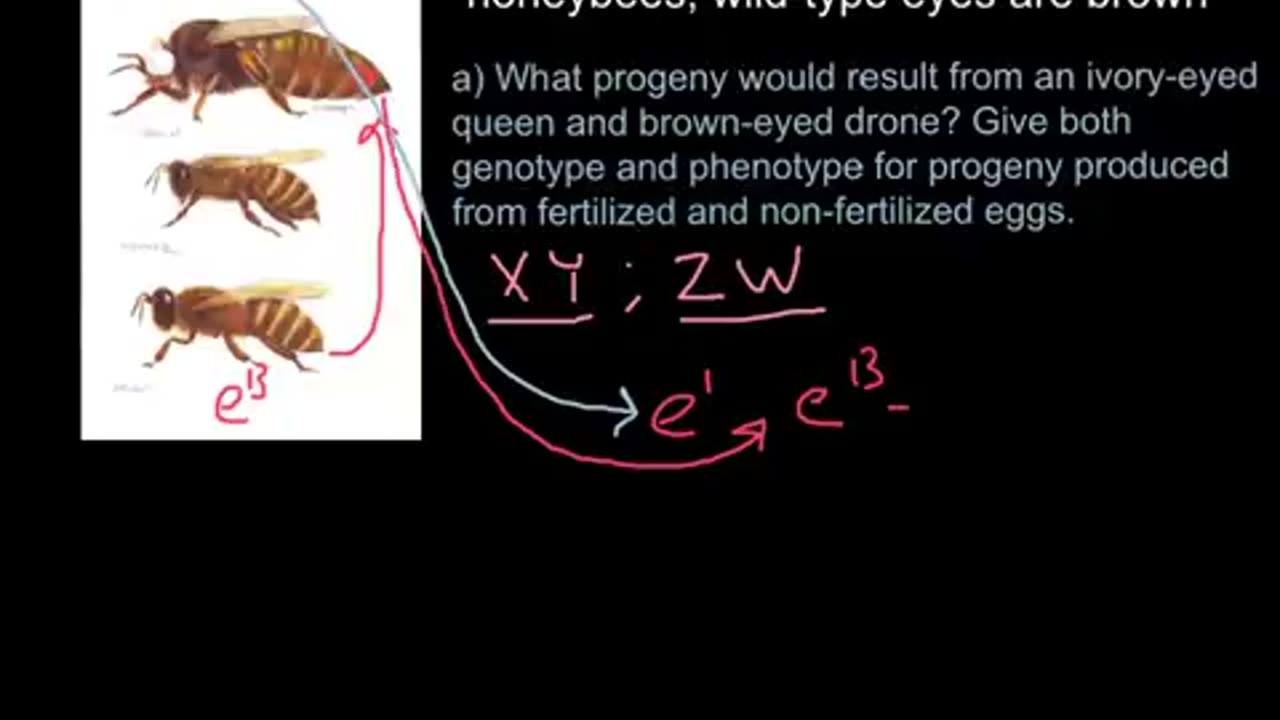Premium Only Content

Haplodyploidy in honeybees
Haplodiploidy
Hymenoptera, the Order of insects that includes the bees, ants and wasps, has an interesting and unusual genetic method of sex determination. Males are haploid--they have only one copy of each chromosome--while females are diploid--two copies of each chromosome. Female Hymenoptera come about in the usual way, with a sperm from a male fertilizing a female's egg. One set of chromosomes comes from the father, the other from the mother, yielding a diploid daughter.
Males, on the other hand, have a mother but no father. Males develop from an unfertilized egg, making them haploid. A female hymnopteran can have sons even if she never mates. Sex determination of this sort--haploid males and diploid females--is called haplodiploidy. Some other kinds of animals have the same sort of method of sex determination, but it is best studied in Hymenoptera.
Gender is actually determined by a single gene (at least in bees, in which this is well explored) (Beye et al. 2003). If there is only one copy of the gene, because the animal is haploid, then the animal develops as a male. If there are two copies (representing two chromosomes) and they differ in their DNA sequences, then the animal is female. In other words, an animal that is heterozygous for the sex determination gene is a female. A homozygous diploid animal develops as a sterile male. In honey bees the homozygous diploids are killed as larvae, representing considerable waste to the colony. This means that inbreeding in the Hymenoptera is costly, and most Hymenoptera avoid inbreeding.
Beyond this intriguing mechanism, haplodiploidy has important consequences that seem to affect social behavior:
If a queen mates only once, her daughters are highly related to each other (called supersisters), because the father's sperm are all identical.
A female is more related to her sisters (on average, 75% similar) than she is to her own daughters (on average 50% similar).
A female is more related to her son (50 % similar) than she is to a brother (on average, 25% similar).
These three factors combine to create a condition in which it may be more advantageous, evolutionarily speaking, for a female to help her mother produce sisters (to the female in question) than to produce her own daughters. Thus haplodiploidy opens the way for the evolution of a worker caste, devoted to helping their mother. If workers evolve under these conditions, then we would expect:
That all workers will be female (males have no special pattern of relatedness in a haplodiploid system that would make working advantageous to them
That workers will help their mother to lay and rear females, but
That workers would prefer to lay their own male offspring, rather than rear brothers
In fact, Hymenoptera workers are uniformly female and conflict between the queen and the workers over who lays the males eggs in a nest is common. The role of haplodiploidy in the evolution of worker Hymenoptera fits into an overall theory of how genetic similarity affects social behavior called kin selection which was developed by W. D. Hamilton.
-
 LIVE
LIVE
Wendy Bell Radio
4 hours agoKnow When To Fold 'Em 2
8,619 watching -
 LIVE
LIVE
LumpyPotatoX2
54 minutes agoFortnite: Bootcamp Training - #RumbleGaming
32 watching -
 LIVE
LIVE
GloryJean
34 minutes agoAggressive MnK Gameplay 🖱️ 6.7 K/D
44 watching -
 51:13
51:13
The Dr. Ardis Show
3 hours ago $0.47 earnedThe Dr. Ardis Show | Why No One Needs a Measles Shot with Dr. Henry Ealy | Episode 06.25.2025
7901 -
 35:03
35:03
Clownfish TV
6 hours agoYouTube Doesn't Want YOU Anymore.
71218 -
 5:37
5:37
Talk Nerdy Sports - The Ultimate Sports Betting Podcast
53 minutes ago3 Locks, 1 Tackle Box: Vasil’s June 25 MLB Moneyline Carnage 💰
-
 LIVE
LIVE
LFA TV
13 hours agoLFA TV ALL DAY STREAM - WEDNESDAY 6/25/25
2,268 watching -
 1:23:37
1:23:37
JULIE GREEN MINISTRIES
3 hours agoLIVE WITH JULIE
69K239 -
 1:07:09
1:07:09
Game On!
18 hours ago $1.46 earnedThe 2025 NBA Draft is Tonight! Will Anyone Watch?
17.3K5 -
 LIVE
LIVE
Bitcoin Policy Institute
2 hours ago2025 Bitcoin Policy Summit
76 watching